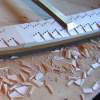I'm currently installing a 6" PVC system in the shop and wanted to upgrade my tool's ports form 4" to 6". The first one I tried was on my Unisaw. To create the inlet, I used the method of creating a template for the desired shape, rolling it on the sheet metal, and tracing it's outline. What I found difficult was getting the flanges on each end correct. The flange tabs weren't even and it wasn't going to be a good seal. I came up with a method that doesn't require as much accuracy or skill with forming metal.
I still used the template, but I didn't add any tabs for the flanges. The only addition to the profile is a 1" of overlap at the seam. The template jig is in the upper-left corner of the picture. For the pipe side, I cut the end off of a PVC cap. Also in the picture is the remainder of the cap. It will be used later. For the saw side, I make a template of my desired shape. Also in the picture is a flange with the same shape cut out.
DSC04082.jpg
Next, I formed the metal and attached one end to the plywood flange that attaches to the saw. I used screws to attach the metal to the top and sides. I left the bottom (where the overlap is) loose for now.
DSC04083.jpg
I installed the remainder of the PVC cap in the other end and secured it with a hose clamp. The ID of the cap is tapered, so it must be installed correctly. This taper also provides a quick disconnect to the mating pipe.
When the hose clamp is tightened, the metal will conform. At the plywood flange side, the bottom of the metal will adjust and can now be screwed into the plywood. The plywood is 3/4" so it has room for error. Last, rivet the seam and seal the pipe to the plywood.
DSC04088.jpg
Here's the installed inlet.
DSC04089.jpg
continued on next post ...





 Reply With Quote
Reply With Quote




